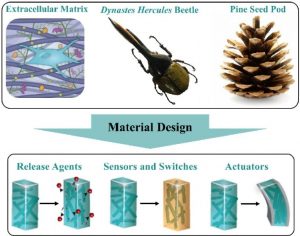Nature serves as a primary source of inspiration for polymer scientists to design responsive materials. Through the study of these natural systems, scientists have uncovered the importance of utilizing fiber structures to achieve functionality. Fiber architectures embedded in polymer matrices can be used to release small molecules, similar to sweat glands in human skin, or even change shape, mimicking the opening and closing of flowers and seed pods.

Placing fibers within a matrix also provides mechanical reinforcement and/or flexibility. By understanding the role of matrix-fiber structures and their resulting material properties, it is possible to design intelligent, synthetic systems known as matrix-fiber composites. In particular, fiber networks have been fabricated through self-assembly processes or engineering techniques such as electrospinning. The networks formed from these approaches are encased in matrices and then utilized to create drug release scaffolds, sensors, and self-healing or shape-memory materials. Applications of these materials span include injury/disease treatment, anti-corrosive coatings, sealants, deployable hinges, and even motion sensing and tracking devices.
Through their recent feature article, Prof. Korley and her co-workers from Case Western explore the design principles used to develop these environmentally-responsive materials that serve as release agents, sensors/switches, and actuators. Each section discusses the structure and functionality of muses found in nature, how the fundamental design of matrix-fiber architectures is mimicked in synthetic systems, and the real-world applications of the resultant composites. Additionally, the authors discuss opportunities for innovation with respect to fiber and composite fabrication, and hope to inspire further investigation and design of multifaceted and multi-stimuli responsive intelligent materials.

















